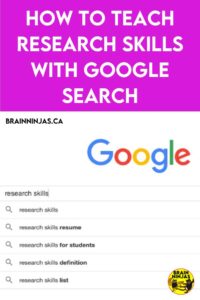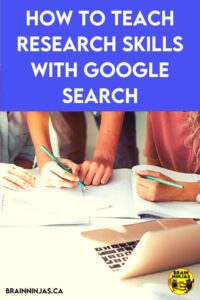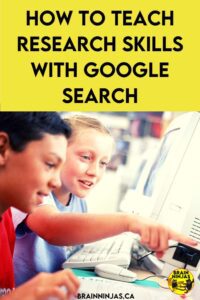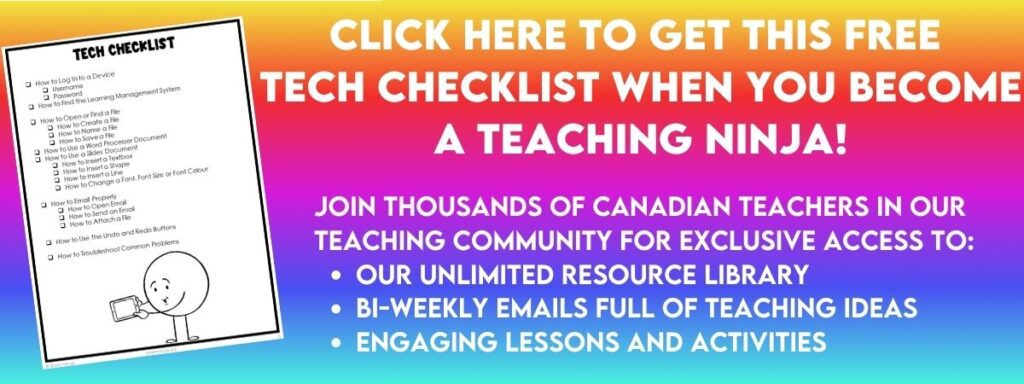
Do your students suck at researching topics? Do they just copy and paste from Wikipedia? Can they find accurate information on their own or do they all just end up at Wikipedia and cite Google Search as a source? Can they use text features or find an actual book?
Research Skills Have Changed
Once upon a time, the librarian at your school would teach everyone how to use the card catalogue, the index and the location of the set of encyclopedias. Those days are gone but don’t forget, if you are lucky enough to still have a librarian at your school-they can be a wonderful resource for research materials.

We don’t have a librarian in our school anymore and we’ve noticed the difficulty students have with doing research. It’s challenging to find material at their reading level and they really have no idea where to start to look for materials.
Our school library is very small and outdated, so our first line of attack in research usually starts online, but we noticed students don’t really know how to search for school-related topics. We needed to teach students some basics of Google Search to help speed up their efficiency and accuracy of information.
Small, Manageable Research Tasks Help Students Develop Research Skills
We created small tasks to help students get better at finding exact information. In our classroom, we often call these challenged scavenger hunts. We create a question of the day and ask students to try to find the information. This question is a clear, simple, “find one piece of information” type question. Most of the time the answer to this question can be found without entering any web pages because it’s shown in the snippet.
Do You Know About Google A Day?
Try A Google a Day. Students can try out Google’s challenge. There’s a new one all the time! Basically, it challenges students to locate information as part of a contest.
Scavenger Hunts
We’ve created some challenges for students to use their search skills as well as mapping, books and atlases. These activities can be used as standalone activities or one for your early finishers. We’ve even used these all year long because a few students were determined to get every single answer! You can read a more detailed post about Disguise Research Skills as a Scavenger Hunt.
And they can be used with paper or a Google Slides version. This means they can work whether you’re teaching in class or online.
Canadian Geography Scavenger Hunt
This scavenger hunt focuses on geographical locations, lakes, mountains, parks, cities and so much more from all across Canada. Students are asked to locate information that correlates with a specific letter. For example, if the letter is E, it might say, name a capital city. The answer would be Edmonton. Some of the questions only have a specific answer, but many have several. A suggested answer key is included.
Find the Canadian Geography Scavenger Hunt in our TpT Store ($USD) or our BN Shop ($CAN).
Alberta Scavenger Hunt
This scavenger hunt focuses on geographical features of Alberta including locations, lakes, mountains, provincial parks, cities and so much more from all across the province. Students are asked to locate information that correlates with a specific letter. For example, if the letter is C, it might say, name a city. The possible answers might be Calgary, Canmore or Cochrane. Some of the questions only have a specific answer, but many have several. A suggested answer key is included.
Find the Alberta Geography Scavenger Hunt in our TpT Store ($USD) or our BN Shop ($CAN).
British Columbia Scavenger Hunt
This scavenger hunt focuses on geographical features of BC including locations, lakes, mountains, provincial parks, cities and so much more from all across Beautiful BC. Students are asked to locate information that correlates with a specific letter. For example, if the letter is V, it might say, name a city. The possible answers might be Victoria or Vancouver. Some of the questions only have a specific answer, but many have several. A suggested answer key is included so you won’t have to do all the searching yourself.
Find the British Columbia Geography Scavenger Hunt in our TpT Store ($USD) or our BN Shop ($CAN).
For the rest of Canada
Saskatchewan Geography Scavenger Hunt in our TpT Store ($USD) or our BN Shop ($CAN).
Manitoba Geography Scavenger Hunt in our TpT Store ($USD) or our BN Shop ($CAN).
Ontario Geography Scavenger Hunt in our TpT Store ($USD) or our BN Shop ($CAN).
Quebec Geography Scavenger Hunt in our TpT Store ($USD) or our BN Shop ($CAN).
Maritimes Geography Scavenger Hunt in our TpT Store ($USD) or our BN Shop ($CAN).
Newfoundland and Labrador Geography Scavenger Hunt in our TpT Store ($USD) or our BN Shop ($CAN).
Northern Canada Geography Scavenger Hunt in our TpT Store ($USD) or our BN Shop ($CAN).
Geography Scavenger Hunt Bundle in our TpT Store ($USD) or our BN Shop ($CAN).
Collaborative Research Activities Take the Pressure Off
When students know they don’t have to complete a huge project, they are more likely to contribute without feeling the pressure of lots of work. They can learn from their peers while feeling like they are included because they have one little bit of information to find and share.
All students can contribute to collaborative research. Students with reading difficulties can use programs like Google ReadWrite to have the text on websites read to them. For students who read in different languages, they can read the information in their native language (if they are literate in that language) to help them understand concepts. Students who have difficulty completing work will have a much smaller amount to get done so they won’t feel as overwhelmed. Students with a thirst for learning can learn as much as they want at the pace they want.
Collaborative research is great for differentiating!

Collaborative Research-Whole Class
One of our favourite ways to do research is to have the whole class work together to collect the information. This can be done in a few different ways.
Give the whole class one question or a set of questions. For example, if you are researching the Cree people of Alberta. One group of students researches where they lived in the past and where they live now. One group researches some of the different Cree words they can find. Another group researches clothing from the past and how these traditions are honoured currently. Yet another group learns about food from the Cree people in the past and compares it to our modern-day food.
While each group is doing their own research, they are all researching the same topic. When one group comes across information from another group, they share it to save everyone time.
We give each of the groups a giant piece of chart paper where they write down the facts they’ve found. They are encouraged to keep all the links they use information from on a shared Google Document. We use these links to teach students how to write bibliographies, but once they know how they include their own with their research.
When all the charts are completed, we hang them up across the classroom. Students use these facts to do a short writing task where they turn the facts into complete sentences and paragraphs.
This whole activity takes about a day from start to finish with all the teaching, but once we’ve taught it a few times, students can often get this done in just a few hours. And when they are pros, they can even do this with a supply teacher!
Collaborative Research- Jigsaw Method

The project we usually do with our class is studying Indigenous People in Canada in the past. We assign each group a different Indigenous group and they work for a few weeks researching everything including food, clothing, shelters, customs, languages and where they lived in the past. Each group creates a presentation that all the other groups learn from, so it’s important that students find and present accurate information.
Find Indigenous People In the Past Collaborative Research Project in our TpT Store ($USD) or our BN Shop ($CAN). It comes complete with everything you need to do the project, except for the actual books and online resources. It does contain some background information for teachers to use as a frame of reference.
When we are sure students can do some basic research, we usually switch over to a jigsaw method. The premise is that each group researches and presents information about one part of a much larger topic.
Google Search Tools You Need to Know and Teach
The Omnibox
This is where you type your search topic. Yes, you can type a question and often this will get you a result. It can be the exact question from the challenge: What is the capital city of Alberta? You can also use keywords: Alberta capital city. You can ask for a calculation: 2+2= (and yes, it will give you the answer).
Did you know you can do basic math operations in the Omnibox? Maybe you don’t want to teach this to your students.
- addition +
- subtraction –
- multiplication *
- division /
You can also use it to do basic conversions like 28 f = (type that into the Omnibox and see what happens).

Students can search for definitions of words by typing (definition: research). The best part of this feature is you can listen to the word and learn to pronounce it. We use this all the time for our English Language Learners. It’s not perfect, but it’s something.
Search Tools
By clicking on the search tools, researchers can organize materials by date, country, language and all kinds of other preferences to find materials that are more suited.
Some of the choices are: by date or language.
When you are searching through images you can search by type (clip art, blackline, photograph), colour, usage rights and size. They can even search for items that were posted in the last year, month or day-showing that you can find newer information or older information if you need to check your facts over time.
Snippets
Teach students to read through the snippets on the first page of searches to see if they are close. If they are not, they will need to refine their search terms. If they are, show them how ads appear differently than web pages. Show students how businesses appear differently than organizations. This information can help students narrow down their search.
Types of Media
Students can search for all kinds of information when they are searching online. They should remember they can get information from maps, images and videos when they are doing their research, as well as articles, blog posts and websites. Sometimes students forget they can learn things from pictures and photographs.
Are you looking for more research skills?
Check out these posts:
- How to Teach Research Skills With Text Features
- How to Teach Research Skills With The Library
- Must Know Tech Skills You Should Teach Your Students
- More Advanced Tech Skills You Should Teach Your Students
What skills do you think students need to practice when searching online? Share your thoughts with us in the comments below. We love to hear from you!








I had never before heard of “a Google a Day”–what fun!
Yes! Check it out! It’s lots of fun!